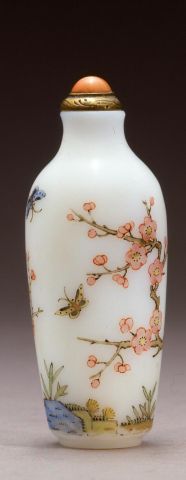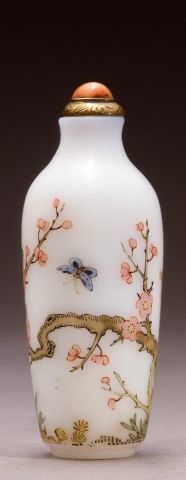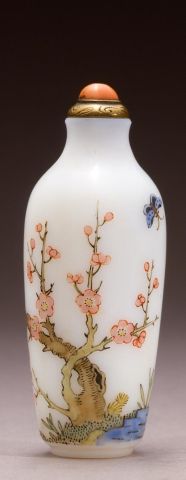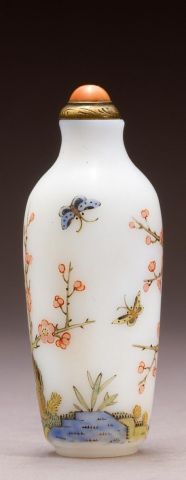



Bottle ID: 00338
YUANMING YUAN, WHITE, BUTTERFLIES & GARDEN LANDSCAPE
Date: 1767-1799
Height: 61 mm
Glass, of tapering cylindrical form with shoulders tapering to a slightly everted mouth and resting on a neatly carved foot, decorated in famille rose enamels with a continous scene of three butterflies flitting among a blossoming prunus tree growing from rockwork beside flowers and grasses.
Imperial, attributed to the Palace Workshops, Yuanming Yuan.
Similar Examples:
Moss, Hugh, Victor Graham and Ka Bo Tsang. The Art of the Chinese Snuff Bottle - The J & J Collection, 1993, Vol. I, p. 351, no. 204.
Sotheby Parke Bernet, Inc., New York, October 3, 1980, lot 83, Mrs. Galia Baylin, Hong Kong.
Moss Hugh. By Imperial Command - An Introduction to Ch'ing Imperial Painted Enamels, 1976, pp. 64-65, Pl. 44.
Provenance:
Clare Lawrence Ltd.
Sotheby's, New York, October 25, 1997, lot 49, Gerry P. Mack
Exhibited:
Annual Convention ICSBS Toronto, October 2007
Published:
JICSBS, Winter 2008, p. 6, fig. 5
JICSBS, Spring 2006, p. 27, fig. 29
Despite the lack of a Guyue Xuan mark on this bottle, it is safe to assume that it is part of that group. The J & J Collection example cited above does have a Guyue Xuan mark, as does an enameled glass bottle with an identical mark in the collection of Mr. and Mrs. T. Dorf, Washington, D.C. The Guyue Xuan mark has long intrigued collectors of snuff bottles. Virtually nothing was known about the Guyue Xuan for many years. This was because, apart from the marks on predominantly enamel on glass bottles, the Guyue Xuan mark appears seldom elsewhere and, until recently, was not thought to appear in any archival documents. In addition to the lack of documentation, the range of enamel on glass bottles bearing these marks are confusing in both their stylistic differences and their quality. Yet a small number of these bottles bear comparison with enamel on glass bottles from the Beijing Palace Workshops.
The diligent research of Peter Y. K. Lam has changed our knowledge to a certain degree. Below is given a partial summary of his stellar article entitled "Studio Marks in Imperial and Court Related Snuff Bottles" published in Hui, Humphrey, and Peter Lam, "The Imperial Connection", 1998.
The Court of Beijing was highly grandiose, entirely formal and was not conducive to every-day living. Thus, the Qing Emperors preferred to live elsewhere and since the time of Kangxi, led to the building of summer palaces and in particular the Yuanming Yuan. The Yuanming Yuan was comprised of three parks; the Yuanming Yuan itself, the Changchun Yuan and the Qichun Yuan. It is the Changchun Yuan which included a hall named the Guyue Xuan. One of the problems in the past was that researchers failed to find any buildings within the Imperial compound named the Guyue Xuan. Guo Baochang (from the Palace Museum, Beijing), who was known to be very thorough in his research, wrote that his searches were fruitless. Even the Emperors' poems and literary works (which were extensive in the case of Qianlong) while often mentioning other halls, failed to ever speak of the Guyue Xuan.
It was Peter Lam's research that finally unearthed the first spark of vital information. The Changchun Yuan complex was begun in the tenth year of Qianlong in 1745, with the Jian Yuan, the Garden of Reflection, being constructed in 1767 (twenty-two years later). This was situated in the south-eastern corner of the Changchun Yuan along the edge of a lake. The main hall of the Jian Yuan was the Airan Jinyun and within that, the Guyue Xuan was located towards the back and connected to the Tuisheng Zhai, which was to be the bed-chamber of the Qianlong Emperor during his retirement. The Guyue Xuan was fairly large in size being recorded as "five columns wide". The Jian Yuan existed from 1767 until 1860 when the whole complex of the Yuanming Yuan was destroyed by the Allied Forces of the British and the French.
< Back to full list
 English
English 中文
中文